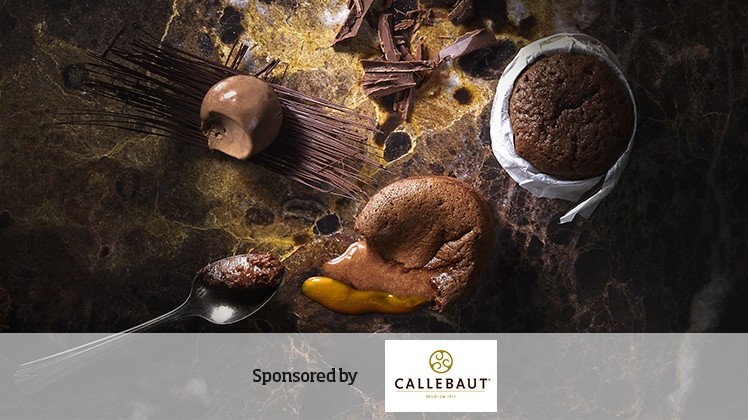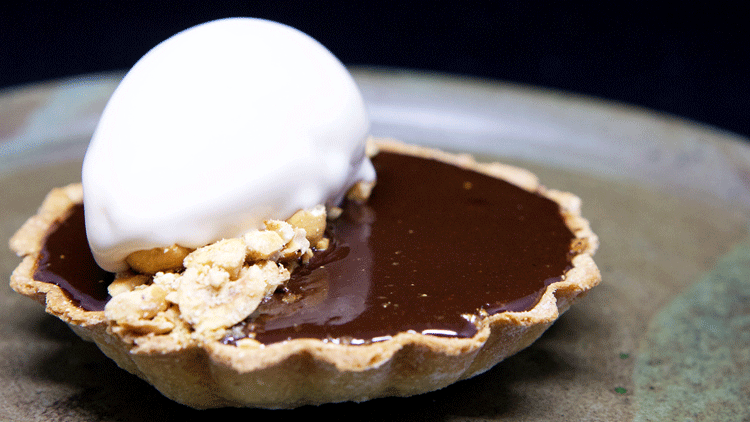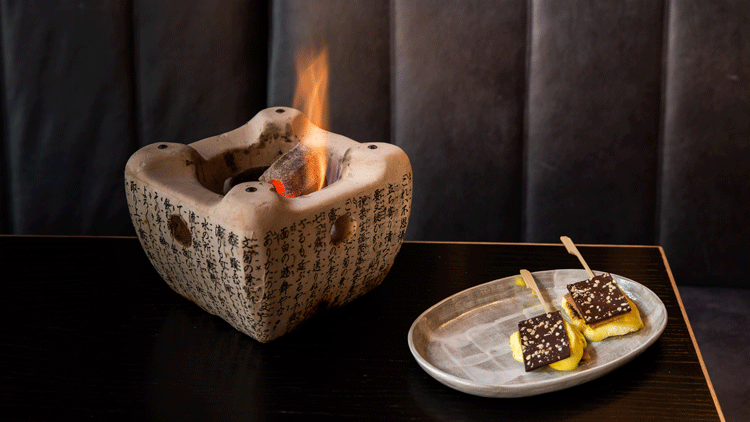Sponsored feature
7 chocolate trends for restaurants

1. Pour-and-melt puds
If there is a more Instagrammed dessert than Bob Bob Ricard’s Chocolate Glory then Restaurant magazine has yet to find it. The signature dish, which involves pouring molten chocolate sauce over a golden chocolate sphere until it disintegrates, has been attracting likes for years, but is now facing competition from a new generation of ‘pour-and-melt’ puds.
Duck & Waffle served a warm banoffee pie in a chocolate sphere last year, which was doused in hot salted caramel sauce, while The Kings Arms gastropub in Cookham and Thai restaurant Chaophraya in Manchester are serving filled chocolate ‘bombes’ that are melted with chocolate or caramel sauces.
Bill’s adapted a melting bombe recipe two years ago to create a Melting Banoffee Sundae, which is topped with a chocolate shell and served with hot salted caramel sauce. It’s the second best selling dessert.
“The dish is incredibly popular due to the theatrics with our guests, explains head of marketing Lesley McIlroy. “We adapted it into a sundae to allow us to showcase seasonal fillings and ice cream.”
2. Share and share alike
Sharing desserts are becoming increasingly popular with both operators and customers. Spectacular selections of different desserts or one towering show-stopper allow restaurants to charge a premium and create a memorable and highly shareable experience.
“Our research suggests sharing desserts appeal to 7 out of 10 diners, and with groups of friends and families often dining together and looking for a sociable dining experience, restaurants should consider adding an array of sharing platters to their menu,” says Anna Sentance, gourmet marketing manager a Callebaut UK and Ireland.
“Callebaut’s Chocolate Box Sharing Platter, full of delicious flavours and textures, includes Callebaut’s smooth chocolate sauces, crunchy biscotti, gooey marshmallows, crumbly shortbread and chewy meringues. Changing menus with the seasons is also a great driver for business and Callebaut’s Raspberry and White Chocolate sharing platter offers diners an elegant dessert that is perfect for this spring and summer.”
Sharing desserts are a big part of the company’s Lasting Impressions campaign, which is designed to help restaurant’s understand the profits that can be achieved with chocolate-based desserts and encourage customers to return time and time again. Callebaut is also encourages restaurants to highlight the provenance of chocolate on menus (with phrases such as ‘real Belgian Chocolate’ and ‘sustainably sourced’) and is providing restaurants with recipe inspiration (see boxout) and point of sale materials.
3. Pass the mushroom powder
Chef Richard Bainbridge makes a chocolate tart with a difference at his restaurant Benedicts in Norwich.
Dark chocolate, praline and hazelnut ice cream are all key ingredients, but it’s a sprinkle of mushroom powder that makes it extra special. Made with thinly sliced ceps dried in the kitchen’s dehydrator for 24 hours, the powder gives the final dish an intriguing umami kick.
“Adding cep powder to chocolate is like adding salt to caramel - it adds a savoury dimension to bitter, dark chocolate,” says Bainbridge.
Other restaurants using savoury flavours in puddings include the Pony & Trap in Bristol, which serves chocolate mousse cake with miso ice cream, and Yauatcha, which makes soy salted ice cream macarons.
“Ingredients are undergoing a globalisation in general,” says Dale DeSimone, executive pastry chef at Hakkasan Group. “Ingredients from all cuisines are becoming more available and popular.”
Savoury dimension: Chefs are combining umami-packed ingredients to chocolate, including mushrooms
4. A taste of terroir
The rise of single-origin chocolates is changing the way pastry chefs create desserts, according to Joanna Brennan, co-founder of Pump Street Chocolate in Suffolk.
Rather than reach for a standard dark, milk or white couverture, they are matching the distinct flavours of single-origin chocolates with other ingredients in dishes.
“Each of our chocolate speaks of the terroir and the type of beans grown on a particular farm,” she says. “They have very different characteristics and chefs are using these as a starting point rather than just the cocoa content.”
Robin Gill’s Italian restaurant Sorella in Clapham has used Pump Street’s 70% Grenada to make a chocolate and fennel-flavoured gelato because the chocolate’s herbal and blackberry notes marry with the fennel’s aniseed flavour. At Yardarm in Leyton, pastry chef Henrietta Inman wanted something with more depth and less bitterness for an Earl Grey and Marmalade tart, so opted for Pump Street’s 75% Jamaica.
5. Non-guilty pleasures
Ethical chocolate is not a new idea, but as chefs learn more about the cocoa industry expectations about sustainability are rising.
Suppliers are taking note with chocolate company Barry Callebaut working on a four-prong sustainability project called Forever Chocolate to lift cocoa farmers out of poverty, eradicate child labour, become carbon positive, and use 100% sustainable ingredients by 2025. Last year the producer announced that 44% of its cocoa beans and other chocolate ingredients were now sourced through sustainability programmes.
“The chocolate industry hasn’t been questioned as much it should have been over the years, but that’s changing,” says bean-to-bar producer Phil Landers at Land Chocolate. “The first question I get from chefs is about quality, but then they want to know about sustainability.”
Land works directly with cocoa farms, which have strong policies on child labour and sustainability. It also pays two or three times the Fairtrade rate for beans. Customers include sustainable restaurant Cub in Hoxton, which uses the company’s waste cacao husks in a crumble and syrup in a cocoa nib parfait.
6. That’s s’mores
Pastry chefs have gone soft and gooey over marshmallow, especially when it’s melted with chocolate and sandwiched between graham crackers in the style of the classic American camp fire treat s’mores.
Pastry chef Dominique Ansel sells frozen s’mores at his eponymous London bakery, which are made with honey marshmallow wrapped around vanilla ice cream and chocolate wafer crisps. They are then blow-torched and served skewered on a smoked willow branch.
At Japanese restaurant Flesh & Buns, there’s added drama with diners melting passionfruit marshmallows over a small fire pit at the table, before layering them with chocolate between graham crackers.
Every component is made from scratch. “It’s labour intensive to form it all into the correct shapes, so costs are higher, but it’s still relatively simple,” says chef and owner Ross Shonhan. “Humans have a primal fascination with fire.”
The secret to getting a good s’more is achieving the right texture in the cookie-like cracker, he adds. “You need to beat the dough enough to get enough air in and add the butter in at the right stage so you get a soft break.”
I melt with you: S'mores at Flesh & Buns
7. Conquering the sugar mountain
Public Health England’s report last year into whether food businesses were on track to meet sugar reduction targets did not make pretty reading for pastry chefs. While food manufacturers had made some progress in reaching the government target of a 20% cut in sugar in products such as cakes and ice cream by 2020, the report found that portion sizes in restaurants were more than double those found in retail.
There are signs that the sector is starting to face up to the challenge, however, with companies including Benugo, Compass and Whitbread reformulating recipes and reducing portion sizes.
Suppliers are also playing their part. Chocolate company Callebaut has launched a new milk chocolate with just 1% added sugar called Ecl1pse, which could help chefs create lower sugar desserts.
“Ecl1pse boasts up to twice the milk and cocoa content compared to regular milk chocolate,” explains Anna Sentance, Callebaut’s gourmet marketing manager. “Chefs and chocolatiers can simply replace their usual milk chocolate with Ecl1pse in some of their most popular recipes, instantly reducing the sugar content by up to 20%, without compromising on flavour.”
Recipe: Raspberry & White Chocolate Profiterole
Serves 4
Ingredients
16 Profiterole cases
125g Fresh raspberries
250g Whipping cream
50g Icing sugar
200g Callebaut® W2 White Chocolate Callets
80ml Whipping cream
Method
1. Place the raspberries and a quarter of the whipping cream into a bowl. Mix with an electric whisk until the raspberries are completely broken up.
2. Strain the mixture through a fine mesh sieve, using a spatula to push all the way through – discard the seeds and remaining pulp.
3. Add the remaining whipping cream and icing sugar and whisk until combined and the cream starts to form soft peaks.
4. Spoon the cream into a piping bag and fill each individual profiterole case.
5. Build the profiterole tower. Heat the Callebaut® W2 White Chocolate Callets in the microwave with the whipping cream, heat for 20 seconds at a time until a smooth sauce is formed.
6. Pour the white chocolate sauce over the profiterole tower. For added theatre do this at the table in front of your diners.
For more recipes and to find out more about the Lasting Impressions campaign head to www.callebaut.com.
Sponsor Profile:
Using only the best ingredients, Callebaut® has been crafting its finest Belgian Chocolate for more than 100 years. Discover the Callebaut® callet range including 70-30-38, 811 Dark Chocolate, 823 Milk Chocolate, W2 White Chocolate and Gold.
For more inspiration, check out our serving suggestions online at FORTHELOVEOFCHOC.COM
































